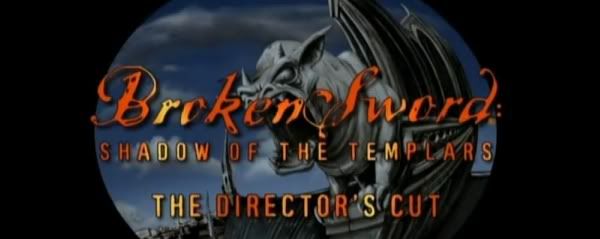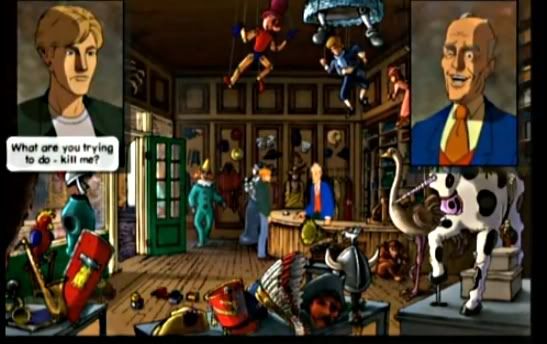
The Point-and-Click Adventure genre is one that many outside the PC gaming scene might not be familiar with. Pioneered in the Golden Days by modern-day Star Wars Spammers Lucasarts, folk were treated to such treats as Day of the Tentacle, Maniac Mansion, and the insane Monkey Island games. As developers ushered in a new technological age of games creation, and 3D became the norm, this genre was left out in the cold, even by the home format of PC enthusiasts. Not one to give up without a fight however, Point-and-Click coughed out a couple more gems from its Deathbed (where it would stay until the advent of Wii and DS); the two Broken Sword games.
Created by Revolution Software, and overseen by Writing-Supremo Charles Cecil, Broken Sword: Shadow of the Templars, and Broken Sword: The Smoking Mirror were given a release on the then-popular PSOne as well as PC, helping to establish a whole new fanbase and give the genre one last hurrah. Both games impressed with sublime Voice Acting (for the time anyway), a clever and thought-provoking script, and a wide range of entertaining characters, all of which lead the series onto 2 direct sequels on future hardware and many more software conversions.
The most recent version of Shadow of the Templars was brought to Wii and DS by Ubisoft, in the form of a Director's Cut. This version offers a new introduction, new scenes and puzzles, whilst keeping intact a large proportion of the original content of the first game. In theory, the Wii Remote's pointer lends itself well to the premise of a Point-and-Click interface, and whilst it has for other titles like Zack & Wiki and the first season compilation of Sam & Max, how does it fare for a classic retro title like Broken Sword?
One of the most important aspects for a title like this is the underlining story, and thankfully Shadow of the Templars doesn't disappoint. Unlike the original, which began with an explosive Accordion leveling a cafe (this scene is still in the game, just at a later stage), the Director's Cut commences with a meeting between Nico; the Second-Main Character, and an important womanizing-figurehead of France, who gets shot by a Mime. Through puzzle-solving and exploration, the plot becomes intertwined with the yesteryear of the Knights Templar; a military organization prominent in the 12th century and one of the more infamous staples of Christian history. Needless to say, those with an interest in this kind of thing will find a lot to like, and for the rest of us it's made accessible and easy to understand, so no problems there.

The new introduction that the Director's Cut wedges in gives insight into one of the more striking new features; conversational portraits on the sides of the screens. These hand-drawn illustrations and animations were designed by Dave Gibbons, an artist that has also worked on Watchmen, Doctor Who and DC Comic artwork. These panels aren't lip-synced with the character voices, but they do animate, and help cover the glaring (if you played the original version) omission of regular lip-movement for the character avatars on the main screen.
The style of the visuals and cutscenes still impress 13 years on from the original release of the game, even if they would hardly make an N64 break out in a sweat, let alone a Wii. For those that look carefully, they will easily notice the sharper textures for the new content as opposed to the old. Inevitable really, but a shame that the whole game couldn't have been brought up the standard of the intro.

The user interface for the Director's Cut is greatly improved from the mouse of old. Tailored for the strengths of the Wii Remote, players will find easy-to-access menu options, large icons of the items needed to combine and examine in the characters bag or pockets, and simple conversational options to choose. In short, the pointer functionality of the game works extremely well, and will never be a hindrance. The Motion detection however, will.
In the original PC and Playstation title, what puzzles there were focused on theory and mouse control. For this Wii re-imagining, Revolution have embraced Motion control for the brain-teasers. Many of the puzzles that do this are new to the game, but most have very poor detection of the player's movements. Via trial and error you will be able to solve these conundrums, but you'll be swearing a fair bit before you do. Thankfully these puzzles make up a relatively small part of the game, but they can be an annoyance.
One other new feature of this version that relates to puzzles, and the whole game in general, is the Hints system. You can toggle it on and off on the starting menu, and you never absolutely have to use it, but as any Action Replay owner can attest to, it's dang hard to resist bending the rules a little. Revolution knew this, and depending on how many hints you use (if any, up to a choice of four at one time), it will impact upon your final score. Through some of the more illogical moments (of which there are precious few), this system can be a useful boon, but it is best used sparingly.
For Sound, the main draw of the game is the Voice Acting. For the newer segments of the game, this is brought to a more modern standard, with good quality speech, and effective role acting. It's a shame then, that Revolution didn't redub the rest of the game as well, since they were able to give George Stobbart (the main character) some new lines that heavily contrast in caliber when you hear the older stuff.
Music-wise, there isn't much to hear, aside from some dramatic tones when discovering a new piece of information or accomplishing a new puzzle. There are some tracks that play as accompanying background aides in places like Syria and Ireland, and this helps with the immersion of the game, but it is nothing iPod-worthy.

Typically, the main storyline of a Point-and-Click Adventure title lasts quite a while, and with the extra content in this version, it would take a first-time player around 10-12 hours to finish. Sadly though, there is little to come back to, as there are no extra features to speak of, aside from a 2 player mode almost exactly that of Super Mario Galaxy; a second pointer on the screen to help the main player along. It doesn't help either that Revolution actually cut some of the dialog trees and choices available to the player originally, and also simplified certain segments of the game for less frustration. Those who know what I mean when I say the word 'Goat', will find this a blessing, but also in the instance of 'Shock Buzzer', a missing interaction of the player's choice will most likely not go down well.
All in all, it is largely difficult to recommend the Director's Cut, despite the extras and the enjoyable core of the game. On one hand, this is arguably the greatest version of the game yet, and on the other, you have the braindead-hicks at Ubisoft charging full-price for it, which is an incredibly overinflated charge. I do urge you to play this game in at least one of its forms, be it the 5 Quid double-pack of the two main games on PC (that also works on Vista), the Playstation original, or the technical marvel that is the GBA version, but you really shouldn't get the Director's Cut unless it's on offer or available to rent; it's just far too expensive.

 Sign In
Sign In By Phoenom
By Phoenom 2609
2609
 Phoenom
Phoenom 

 Link to this post:
Link to this post: 
 Subscribe to this topic
Subscribe to this topic Game Details
Game Details
 Out now
Out now  Out now
Out now  None
None  Out now
Out now  I own this game
I own this game
 I want this game
I want this game Features
Features





 Top
Top


Who owns this game?
xxThe_Dice_manxx
jesusraz
DJvert